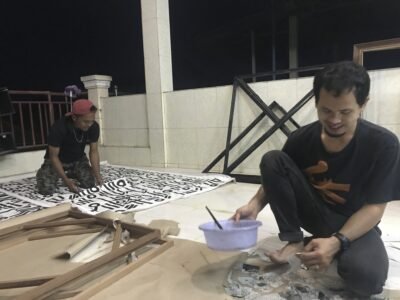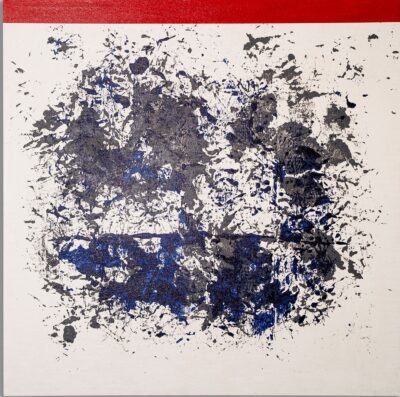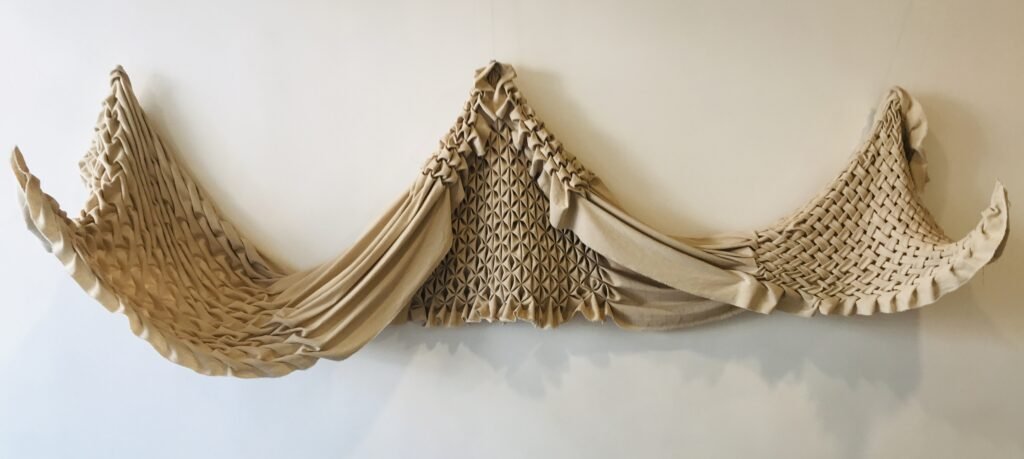Homeless Artists Collective: Artistic Synergies from Phnom Penh
by Danielle Khleang

Left to right: Sosoth “Kwan” Sovankong, Many Sin, and Shanghai Chang form Cambodia’s Homeless Artists Collective. Image courtesy of Homeless Artists Collective.
Many Sin, Sosoth “Kwan” Sovankong, and Shanghai Chang are the artists behind the Phnom Penh-forged Homeless Artists Collective. Founded in 2018, the group formed around their common interests in the arts and attending exhibitions. It was clear they shared an artistic synergy and after a year of living in a creative space together, Homeless Artists Collective was coined following a chance encounter with a noodle shop owner after attending a talk at Kon Len Khnhom, a community arts space founded by Meta Moeng supporting independent and free-thinking. Retelling the story Kwan said:
There was one day when the three of us joined a talk at Kon Len Khnhom. I was hungry and I went to buy noodles and the owner was trying to give me some money and saying like, ‘hey don’t sit here.’ I thought it was kind of funny because I thought I looked good with my fashion. I went back and shared the story with Many and Shanghai, and Shanghai had a similar story, and that’s how it came to be. Homeless sort of started itself and we’re proud to call ourselves homeless.
Set to the backdrop of their friendship, Homeless Artists Collective let their process of collaboration develop organically. According to Many, “those first two years, we just let [the collective] go to see how we created our work and learn about each other personally. We mainly worked individually and then would exhibit our works together in the gallery, but they still complemented each other.”
Each brings their unique perspective and interests to the collective resulting in dynamic and textured artworks.

Studio moments with Homeless Artists Collective. Image courtesy of Homeless Artists Collective.

A self-taught artist and the oldest in Homeless, Many’s early pieces included iron sculptures, lightboxes and drawings printed as postcards depicting abstracted genitalia inspired by Linga and Yoni found at Angkor Wat temple as an engagement with rigid notions of sex and sexuality. During his stay as Pisaot artist-in-residence at Sa Sa Art Projects in 2021, Many moved to painting on canvas and further worked with abstraction. Learning about his own aesthetic taste during the residency, Many’s current painting works with primary colours and reflects on the dynamics of humanity as we experience this intense moment of social and environmental issues.
Many, ‘G 10’, 2020, 11 x 15cm. Image from Genital Project series in which this and similar depictions of genitalia were printed as postcards. Image courtesy of Homeless Artists Collective.

Multidisciplinary artist, hip hop culture runs through Kwan’s work. Image courtesy of Homeless Artists Collective.
Before moving to Phnom Penh in 2016 to pursue a degree in civil engineering, Kwan was already a graffiti writer in his home province but found room for his practice to grow in the urban environment. Kwan is also a musician known for his hip-hop and R&B vibe. Though, it was not until he met a filmmaker who brought him to an exhibition at Sa Sa Art Projects that he started to try new visual artforms. There, he was given the opportunity to work at the art space by Co-founder and Creative Director, Vuth Lyno. Like Many, Kwan now works with canvas painting. His paintings distinctly reflect his hip-hop background with the inclusion of Sanskrit-esque letters which speak to his graphic practice.
Still image from Shanghai’s breakthrough film ‘mélancolie (n.)’, 2018, Seven minutes. Image courtesy of Homeless Artists Collective.
Shanghai, a university student majoring in fashion, is best known for his photography and video work. Attracted to photography and film after taking a fashion photography course at school, he began experimenting artistically:
At first, people didn’t take me seriously as an artist because I was doing fashion… In 2017 I met a curator, he was a big influence on me. [Rogler Nelson] showed me experimental videos from Thailand and Europe and I found it very interesting and thought I could do something similar.
Shanghai’s first film, mélancolie (n.) (2018) was overwhelmingly well received. Addressing the personal theme of mental health, it was selected for the Cambodian International Film Festival and went on to tour Southeast Asia through SeaShorts – S Express Cambodia, a programme that gives annual insight into the development of filmmaking in the region.
Though working with different mediums and subjects, Homeless Artists Collective’s most recent group exhibition, Talking Textures held at the commercial gallery Sra’Art Studio, was a step toward new modes of collaboration. Speaking on this Shanghai said:
This was the first time that we really worked together on the same concept. We talked about what we wanted to do, our inspirations. It was the first time we collaborated intentionally as a collective. It was more than just about the influence we could have on each other.
Creating artwork for Talking Texture was also the first time they were physically unable to meet due to the restrictions of the pandemic. Dispersed and coordinating digitally, the three made distinct bodies of work brought together by the common experience of separation and emphasis on texture. Many’s paintings meditate on intimacy while Kwan’s work engages the soil of his home province and Shanghai’s textile sculptures brought meaning to his days in lockdown
The oxymoron ‘social distancing’ has become the defining practice of the last two years. Thinking through this new state of human intimacy, Many disrupted the usual expectations of the art viewer’s gallery experience and invited guests to touch the artworks to feel the textures of the paint and canvas. Substituting human-to-human contact with human to art-object intimacy amidst a global pandemic indicates the subtle flowing of one epoch into another. Manoeuvring through top-down regulations for public health, the artist offered a sensory experience with the inanimate that steps toward the horizon of growing human-nonhuman relationships.

Many Sin, ‘Red’,’ 2021, acrylic on canvas, 80 x 80cm. Image courtesy of Homeless Artists Collective.

Perhaps the most isolated of the collective during peak pandemic restrictions, Kwan returned to his home province where he merged his hip hop influences with the literal earth of his hometown by overlaying mixed dirt and paint on top of Sanskrit-esque motifs with varying visual effects among his recent works. While the script motif in ‘Out of Space’ (2021) seems to flow vertically down the canvas, the mixed dirt and paint flows across the horizontal plane of the painting. In the image one can read two independently functioning logics: the alluring brightness of an illegible script and the thick and thin workings of liquid moving across and obscuring it.
Kwan, ‘Out of the Space’, 2021, dirt, acrylic on canvas 110 x 134cm. Image courtesy of Homeless Artists Collective.

Shanghai, ‘Old Habits’, 2021, fabric and thread, 50 x 225cm. Image courtesy of Homeless Artists Collective.
When Shanghai entered the first lockdown along with the rest of Phnom Penh, he thought that he had quit fashion. After spending more time in his room, surrounded by fabrics, he picked up working with patterns again. Self-described as “symmetry OCD” and influenced by a Japanese smocking book, during lockdown, Shanghai began obsessively creating large sculptural textiles to feel good about his days:
During the lockdown, I was unable to work for a long time and this project was a way of staying productive. I would spend at least three to five hours a day on it, so I could feel like ‘I made something today.’ Everyday, the more I did, the bigger the pieces would get.
Part of the beauty in the sculptural textiles for the artist is the way the imperfections and challenges of smocking disappear when one takes in the finished pieces as a whole:
To do smocking I had to draw vertical and horizontal lines which are very difficult to do on fabric. The more you do it, the more the line gets crooked. I learned to compensate for my errors by adjusting the next line and I realized individually it didn’t need to be perfect. It wasn’t technically perfect, but it looked beautiful.
Since Homeless Artists Collective’s first exhibition under a common theme, the three have once again taken on another first step. With Many moving to Paris, France the group is now an international collective. In 2022 they have plans to do a residency together.
Learn more about the collective here.
Quotes have been edited lightly for length and clarity.

